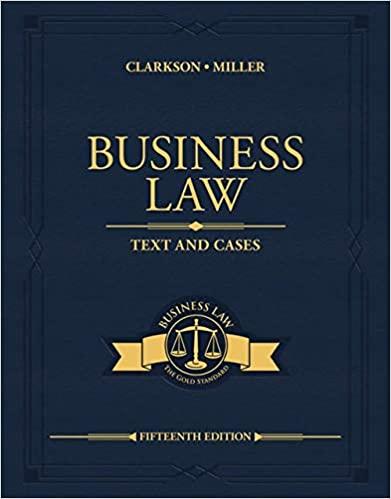Question
Under tort law, a failure to exercise the reasonable person's duty or standard of care that causes harm to another party is referred to as
Under tort law, a failure to exercise the reasonable person's duty or standard of care that causes harm to another party is referred to as negligence. Several things need to be demonstrated in order to prove negligence: Duty: There must be a duty of care owed by the defendant to the plaintiff. Duty is the legal term for the responsibility to act in a way that prevents harm to other people. In Mrs. Liebeck's case, McDonald's would be held accountable for this duty of care since they are obligated to make sure all of their patrons are safe, which includes serving hot coffee at a safe temperature (Hot Coffee). Breach of Duty: The defendant must have failed to act in a way that a reasonable person would have in the same situation in order to violate the duty of care. The evidence in Mrs. Liebeck's case indicates that McDonald's violated its duty of care by serving coffee at temperatures that were much higher than what would be deemed safe to consume (Hot Coffee). Harm: The plaintiff must have suffered harm as a result of the defendant's breach of duty. In the instance of Mrs. Liebeck, the extremely hot coffee that McDonald's served her directly resulted in her suffering from severe burns (Hot Coffee). Causation: The plaintiff's harm and the defendant's violation of duty must be related in some way. Stated differently, the harm had to have been an expected outcome of the defendant's conduct. The scalding hot coffee Mrs. Liebeck received from McDonald's was the direct cause of her injuries, proving causation (Hot Coffee). When these factors are applied to Mrs. Liebeck's case, it becomes clear that she had to demonstrate that McDonald's had a duty of care to her as a customer, that McDonald's violated this duty by serving her coffee that was too hot, that she got severe burns from the hot coffee, and that there was a direct and causal connection between her injuries and McDonald's violation of her rights. In "Hot Coffee," it is revealed that McDonald's frequently served coffee at temperatures between 180 and 190 degrees Fahrenheit, which is much hotter than what is deemed safe for ingestion and industry standard (Miller, 2022). The claim that McDonald's violated Mrs. Liebeck's duty of care by serving coffee at dangerously high temperatures is supported by this evidence. In addition, the extent of Mrs. Liebeck's injurieswhich included third-degree burns that needed surgery and skin graftshighlights the harm that McDonald's negligence caused her. The documentary also supports the element of breach of duty by highlighting McDonald's knowledge of prior burn incidents linked to its coffee and its inability to take appropriate action to address the problem. Furthermore, the element of causation is established by the fact that Mrs. Liebeck's injuries were directly brought on by the scalding hot coffee she received from McDonald's. In conclusion, Mrs. Liebeck's case highlights the elements of negligence, as McDonald's violated its duty of care by serving Mrs. Liebeck coffee that was too hot, seriously injuring her. The evidence in "Hot Coffee" highlights McDonald's negligence in serving coffee at dangerously high temperatures, supporting the legal analysis of these elements.
Please review the above post in two hundred words using legal terms as Legal term to include
Duty (Was there a duty owed to the victim?)
Breach of the duty (reasonable person test)
Harm (actual harm, can be physical, property, reputation, emotional, etc.)
Causation Factual (But for test)
https://docuseek2-com.mutex.gmu.edu/cart/product/519
(link opens in a new window - watch first 15 minutes only)
Step by Step Solution
There are 3 Steps involved in it
Step: 1

Get Instant Access to Expert-Tailored Solutions
See step-by-step solutions with expert insights and AI powered tools for academic success
Step: 2

Step: 3

Ace Your Homework with AI
Get the answers you need in no time with our AI-driven, step-by-step assistance
Get Started


